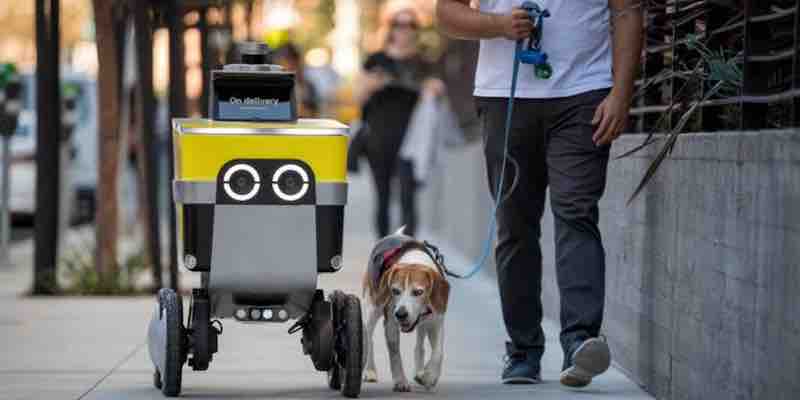Robo-Runners on the Rise: The Tug-of-War Between Food Delivery Bots and Public Sentiment

Delivery robots are increasingly used in cities and college campuses for food delivery. While companies like Serve Robotics are securing significant funding and universities are adopting these robots, there’s a growing backlash. Some individuals have resorted to vandalizing or even stealing from these robots. Despite the technological advancement, a significant portion of consumers (71%) have expressed disinterest in robotic food delivery, with concerns ranging from potential job loss to reliability and privacy issues.
| Key Developments | Details |
|---|---|
| Expansion of Delivery Robots | – Serve Robotics raised $30 million. – Universities are introducing food delivery bots. |
| Backlash and Vandalism | – Viral videos show robots being attacked. – Incidents reported in Los Angeles and Tennessee. |
| Consumer Sentiments | – 71% uninterested in robotic delivery. – Concerns: job loss (73%), reliability (65%), privacy (33%). |
The article is “Food Delivery Robots Expand Amid Backlash, Theft.“
Harmonizing Delivery Robots with Public Sentiment to Reduce Vandalism and Theft
| Strategy | Description | Benefits |
|---|---|---|
| Community Engagement and Education | Engage with local communities through workshops, open houses, or interactive sessions about delivery robots. | Demystifies technology, showcasing its benefits and reducing perceptions of threat. |
| Enhanced Security Features | Equip robots with cameras, alarms, and tracking systems for security. | Deters potential vandals and thieves and provides evidence in case of incidents. |
| Collaboration with Local Authorities | Work with local law enforcement to ensure understanding and collaboration. | Deters potential vandals and thieves, and provides evidence in case of incidents. |
| Public Awareness Campaigns | Quicker response in case of incidents fosters a sense of shared responsibility. | Shifts public perception to view robots as beneficial community additions. |
| Personalization and Branding | Design robots with friendly appearances, greetings, or music. | Reduces intimidation, making robots more approachable and accepted. |
| Feedback Channels | Create channels for public feedback or concerns about the robots. | Involves the community in the process and provides valuable insights for improvement. |
| Pilot Programs | Run pilot programs in select areas before a full-scale launch. | Identifies potential challenges and allows for proactive adjustments based on community feedback. |
This is a structured overview of strategies to harmonize the introduction of delivery robots with public sentiment, aiming to reduce incidents of vandalism and theft.
Ensuring Employment Opportunities:
| Strategy | Description | Benefits |
|---|---|---|
| Retraining and Upskilling | Offer training programs for delivery personnel transitioning into robot maintenance, customer support, or logistics coordination roles. | Utilizes existing workforce in new capacities, ensuring minimal job displacement. |
| Hybrid Delivery Models | Offer training programs for delivery personnel transitioning into roles like robot maintenance, customer support, or logistics coordination. | Retains human touch in the delivery process, catering to diverse customer preferences. |
| Expansion into New Services | Diversify services beyond food delivery, such as parcel delivery, grocery shopping, or personal shopping. | Combine robotic and human delivery, allowing customers to choose their preferred delivery method. |
| Robot Supervision Roles | It opens up new job avenues, leveraging the skills of delivery personnel in different sectors. | Ensures human intervention in case of robot malfunctions or complex delivery scenarios. |
| Enhanced Customer Experience | Focus on roles that enhance the human touch in customer service, such as personalized order recommendations or real-time support. | Differentiates from purely automated services, adding value through human interaction. |
| Local Partnerships | Collaborate with local businesses or artisans to offer exclusive delivery items or experiences. | Creates niche delivery opportunities that require a human touch, fostering community ties. |
| Innovation in Food Prep | Introduce roles related to innovative food preparation, packaging, or presentation that robots can’t replicate. | Emphasizes the human element in food quality and creativity, ensuring continued demand for human expertise. |
This table provides a structured overview of potential strategies the food delivery industry can adopt to ensure employment opportunities, even as automation becomes more prevalent.
Building Trust in Automation:
| Strategy | Description | Benefits |
|---|---|---|
| Transparency in Operations | Offer robotic and human delivery options, allowing customers to choose based on their comfort level. | Builds trust by demystifying the technology and showcasing its reliability. |
| Hybrid Delivery Models | Offer both robotic and human delivery options, allowing customers to choose based on their comfort level. | Provides flexibility and caters to diverse customer preferences, retaining the human touch when desired. |
| Personalized Robot Interactions | Equip robots with features like voice interfaces, custom greetings, or the ability to play music. | Communicate how the robotic systems work, their safety measures, and their reliability statistics. |
| Feedback Mechanisms | Implement systems where customers can provide feedback or report issues with robotic deliveries. | Allows companies to continuously improve and address concerns, demonstrating a commitment to customer satisfaction. |
| Human Support Integration | Ensure that a human support team is always available to assist with any issues related to robotic delivery. | Provides assurance that human intervention is available, addressing concerns about purely automated systems. |
| Community Engagement | Implement robust security protocols to protect customer data and ensure the safety of the delivery process. | Fosters familiarity and reduces apprehension by allowing hands-on experiences with the technology. |
| Robust Security Measures | Assures that human intervention is available, addressing concerns about purely automated systems. | Addresses concerns about privacy and safety, ensuring customers feel secure when using robotic delivery. |
The companies can adopt to build trust and reliability in automated delivery systems while addressing concerns about the lack of personal interaction.